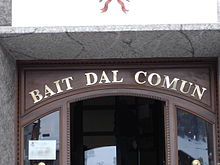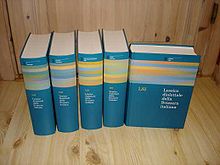Lombard language
error: ISO 639 code is required (help)
The term Lombard refers to a group of related varieties spoken mainly in Northern Italy (most of Lombardy and some areas of neighbouring regions) and Southern Switzerland (Ticino and Graubünden). However, the two main varieties (Western Lombard or Insubric and Eastern Lombard or Orobic) are so different and not mutually comprehensible, so they are often considered as separated languages.
Present situation
Status
Lombard is considered as a minority language, structurally separated from Italian by the Ethnologue reference catalogue and by the UNESCO Red Book on Endangered Languages. Although sometimes erroneously referred to as an Italian dialect (even by some of its speakers), Lombard is not closely related to the Italian language, Lombard and Italian belonging to different branches of the Romance language family.
Position on the Romance language tree
From the point of view of language genealogy, Lombard and Italian are not so closely related, having in common only the fact of being neither Eastern nor Southern Romance. Romansh, Friulian, French, Provençal, Catalan and even Castilian or Portuguese are closer relatives of Lombard than Italian.
Varieties
A major distinction is usually made between Western (or Insubrian) and Eastern (or Orobic) varieties. All the varieties spoken in the Swiss areas (both in canton Ticino and canton Graubünden are Western, while both Western and Eastern varieties are found in the Italian areas. The varieties of the Italian provinces of Milan, Varese, Como, Lecco, etc. belong to the Western subgroup, while the ones of Bergamo, Brescia, etc. are Eastern. The varieties of the Valchiavenna and the Valtellina – together with the four Lombard valleys of Swiss canton Graubünden, although showing some peculiarities of their own and some traits in common with Eastern Lombard, should be considered as Western. Also, dialects from Verbano-Cusio-Ossola province, Novara province and Valsesia (part of Vercelli's province) are more Western Lombard than Piedmont.
The Lombard variety with the oldest literary tradition (dating back to the thirteenth century) is that of Milan, where nowadays Milanese, the native Lombard variety of the area, has almost completely been superseded by Italian. Ticinese is a comprehensive denomination for the Lombard varieties spoken in Swiss Canton Ticino (Tessin), while the Ticinese koiné is the Western Lombard koiné used by speakers of local dialects (particularly those diverging from the koiné itself) when communicating with speakers of other Lombard dialects of Ticino, the Grisons or Italian Lombardy. This koiné is not very unlike Milanese and the varieties of the neighbouring provinces on the Italian side of the border. The more distant Lombard varieties are not readily intelligible with each other.
Lombard in writing
Lombard-speaking communities (or, more precisely, the exiguous percentage of their members who could read and write) have been using for centuries some form of Latin or Tuscan (later known as Italian) as the language of written communication, not developing a standard written Lombard variety.

There is no generally recognised standard orthography, but rather a few well-established conventions (like the one that word-final [ʧ] and [k] should be written as -c and -ch respectively) and some competing traditions (e.g. [ø] and [y] are written oeu and u respectively according to the traditional Milanese orthography (well established in Milanese literature), while in Switzerland and in many Italian areas ö and ü are used respectively; this is also the most generalised trend nowadays).

The CDE - Centro di dialettologia e di etnografia of Bellinzona, Switzerland (cf. below) has devised a rather advanced orthographic system used in its publications. This system does not break with the established conventions and at the same time it is able to render the actual pronunciation rather faithfully. The CDE system, however, is flawed by some inherent deficiencies, in particular as far as prosody is concerned, and in some situations it fails to distinguish between long and short vowels (e.g. the coda -asc is written identically in casc [kaʃ] 'leaf-bud' and masc [maːʃ] 'May', although the vowel is actually short in the former case and long in the latter).
An improved system trying to reconcile the main fatures of the CDE system with the necessary amendments was published in 2003 (cf. Bibliography). This is the system used in the present article. It is the only system proposed so far featuring a unified set of writing rules meant to cover all the Lombard varieties of both Switzerland and Italy.
Features
- Note: unless otherwise specified, all examples below are forms common to most Western Lombard varieties, including the Ticinese koiné. The orthography is a compromise between traditional orthographies and a recently proposed unified system for all Lombard varieties, with phonetic transcriptions (when given) in IPA.
Phonetics and phonology
Unlike most Romance languages, many Western Lombard dialects have vowel quantity oppositions, e.g. paas [paːs] 'peace' vs. pass [pas] 'step', 'mountain pass'; ciapaa [ʧaˈpaː] 'caught, got m.' vs. ciapà [ʧaˈpa] 'to catch, get'.
The phoneme inventory of most Lombard varieties includes the front rounded vowels [y] and [ø].
Syntax and lexicon
Another uncommon feature for a Romance language is the extensive use of idiomatic phrasal verbs (verb-particle constructions) much in the same way as in English and other Germanic languages. E.g. trà 'to draw, to pull', trà via 'to waste, to throw away', trà sü 'to vomit, to throw up', trà fö(ra) 'to remove, to take away'; magnà 'to eat', magnà fö(ra) 'to squander'.
Usage
Standard Italian is widely used in Lombard-speaking areas. However, the status of Lombard is quite different between the Swiss and Italian areas. This justifies the view that nowadays the Swiss areas (sometimes referred to as Swiss Lombardy (Lombardia svizzera)) have become the real stronghold of Lombard.
In Switzerland

In the Swiss areas, the local Lombard varieties are generally better preserved and more vital than in Italy. No negative feelings are associated with the use of Lombard in everyday life, even when interacting with complete strangers. Some radio and television programmes in Lombard, particularly comedies, are occasionally broadcast by the Swiss Italian-speaking broadcasting company. Moreover, it is not uncommon for people from the street to answer in Lombard in spontaneous interviews. Even some television ads in Lombard have been reported. The major research institution working on Lombard dialects is located in Bellinzona, Switzerland (CDE - Centro di dialettologia e di etnografia, a governmental (cantonal) institution); there is no comparable institution in Italy. In December 2004, the CDE released the LSI, a dictionary in 5 volumes covering all the Lombard varieties spoken in the Swiss areas. This is so far the most comprehensive Lombard language resource ever published (more than 4,500 pages and about 57,000 lexemes with over 190,000 spoken variants).
In Italy
The usage of Lombard dialects is generally scarce in present-day Italy. This is due to a number of historical and social reasons: speaking a non-standard variety is considered a sign of poor schooling or low social status, and its usage has been historically discouraged by Italian politicians, probably as it was regarded as an obstacle to the attempt to create a 'national identity'. Such and related issues are also the reason why speaking a dialect of certain non-Italian minority languages is politically controversial in Italy, as presently the political party most supportive of Lombard (and of the varieties of Northern Italy in general) is the Northern League (in the past, on the other hand, the leftist parties were the ones giving support to local varieties). Today, in most areas of Italian Lombardy, people below forty years old speak almost exclusively Standard Italian in their daily lives, because of schooling and television broadcasts in Standard Italian. People who speak a Lombard dialect will almost always speak Standard Italian (or an approximation of it) to an outsider. A certain revival of the use of Lombard has been observed in the last decade, when the use of Lombard has become a way to express one's local identity and to distance oneself from Mediterranean-oriented mainstream Italian culture.
The popularity of modern artists singing their lyrics in some Lombard variety (in Italian "rock dialettale") is a relatively new but growing phaenomenon involving both the Swiss and Italian areas. The most well-known of such artists is probably Davide Van de Sfroos (aka. Davide Bernasconi).
Bibliography
- Jørgen G. Bosoni, «Una proposta di grafia unificata per le varietà linguistiche lombarde: regole per la trascrizione», in Bollettino della Società Storica dell’Alta Valtellina 6/2003, p. 195-298 (Società Storica Alta Valtellina: Bormio, 2003). A comprehensive description of a unified set of writing rules for all the Lombard varieties of Switzerland and Italy, with IPA transcriptions and examples.
- Bernard Comrie, Stephen Matthews, Maria Polinsky (eds.), The Atlas of languages : the origin and development of languages throughout the world. New York 2003, Facts On File. p. 40.
- Stephen A. Wurm, Atlas of the World’s Languages in Danger of Disappearing. Paris 2001, UNESCO Publishing, p. 29.
- Glauco Sanga: La lingua Lombarda, in Koiné in Italia, dalle origini al 500 (Koinés in Italy, from the origin to 1500), Lubrina publisher, Bèrghem
- Studi di lingua e letteratura lombarda offerti a Maurizio Vitale, (Studies in Lombard language and literature) Pisa : Giardini, 1983
- Brevini, Franco - Lo stile lombardo : la tradizione letteraria da Bonvesin da la Riva a Franco Loi / Franco Brevini - Pantarei, Lugan - 1984 (Lombard style: literary tradition from Bonvesin da la Riva to Franco Loi )
- G.Hull: the linguistic unity of northern Italy and Rhaetia, PhD thesis, University of Sidney West, 1982
- Letteratura dialettale milanese. Itinerario antologico-critico dalle origini ai nostri giorni - Claudio Beretta - Hoepli, 2003.
- I quatter Vangeli de Mattee, March, Luca E Gioann - NED Editori, 2002.
- Canzoniere Lombardo - a cura di Pierluigi Beltrami, Bruno Ferrari, Luciano Tibiletti, Giorgio D'Ilario - Varesina Grafica Editrice, 1970.
External links
- Ethnologue: Languages of the World (unknown ed.). SIL International.[This citation is dated, and should be substituted with a specific edition of Ethnologue] (the Ethnologue report for Lombard in Switzerland contains a misprint: it says "Ticinese is the form of Lombard used in the home in Italy" where "in Switzerland" is intended)
- Centro di dialettologia e di etnografia del Cantone Ticino.
- Istituto di dialettologia e di etnografia valtellinese e valchiavennasca.
- LSI - Lessico dialettale della Svizzera italiana.
- VSI - Vocabolario dei dialetti della Svizzera italiana.
- DOSI - Documenti orali della Svizzera italiana.
- RTSI: Acquarelli popolari, some video and audio documents (interviews, recordings, etc. of writers from Ticino) in Ticinese varieties (please notice that the metalanguage of this site is Italian, and that some of the interviews are in Italian rather than in Ticinese Lombard).
- UNESCO Red Book on Endangered Languages: Europe. Potentially endangered languages, where Lombard is classified as a potentially endangered language.
- Il galloitalico di Sicilia, varieties with Gallo-Romance traits spoken in 5 provinces and 24 villages in Sicily by the descendants of Lombard emigrants.
